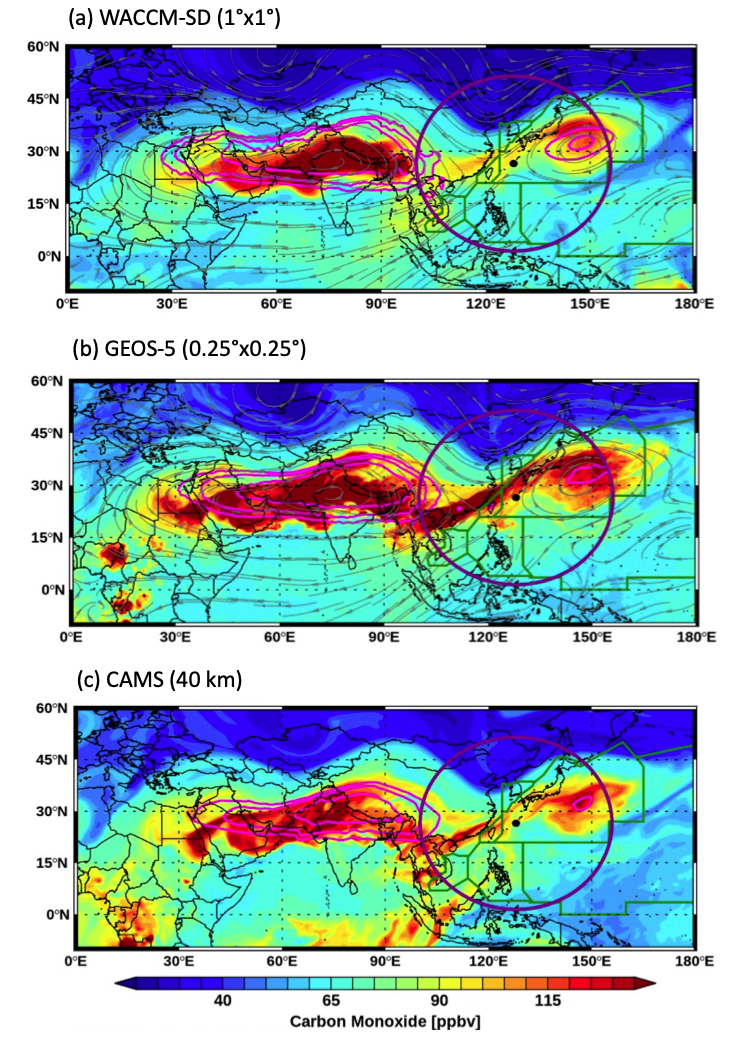Asian Monsoon Transport over the Western Pacific
The Asian Summer Monsoon (ASM) is the largest meteorological pattern in the Northern Hemisphere (NH) summer season. Persistent convection and the large anticyclonic flow pattern in the upper troposphere and lower stratosphere (UTLS) associated with ASM produces a prominent enhancement of chemical species of pollution and biomass burning origins in the UTLS (Park et al., 2007; Randel et al., 2010), as well as a distinct and annually recurring aerosol layer (Vernier et al., 2011, 2015). The monsoon convection occurs over South, Southeast, and East Asia, a region of uniquely complex and rapidly changing emissions tied to both its high population density and significant economic growth. The coupling of the most polluted boundary layer on Earth to the largest dynamical system in the summer season through the deep monsoon convection has the potential to create significant chemical and climate impacts. To investigate the impact, the StratoClim project, funded by European Commission, conducted an airborne campaign using the Geophysica high altitude research aircraft. The campaign obtained a large amount of new information on aerosol size, mass and chemical composition, indicating the significant perturbation of ASM to the local UTLS composition during July-August 2017 from Kathmandu, Nepal.
While these new data are still in the preliminary stage of analysis and interpretation, the initial information points to an important question: How much of these heavily impacted air masses exits the region of active convective redistribution and is transported out of the region to have global impact? The airborne study under the Asian summer monsoon Chemical and Climate Impact Project (ACCLIP) is an important step to answer this question. Understanding the ASM UTLS dynamical variability and the transport pathways is a critical element for the campaign to successfully sample the ASM processed chemical and aerosol content. As part of the pre-study for the campaign planning, satellite data and the output of multiple models are analyzed. The results support the ACCLIP campaign hypothesis that the sub-seasonal scale eddy shedding process actively transport the ASM processed air to the greater western Pacific region (Honomichl and Pan, to be submitted). Figure 1 shows an example of Carbon Monoxide (CO) mixing ratio at 150 hPa level. CO is a widely used transport tracer for the boundary layer pollutants. The example shows that the three state-of-art global models, NCAR WACCM, NASA GOES-5, and ECMWF CAMS, although using different resolutions and emissions, are consistently indicating the transport of ASM air mass over the greater western Pacific via the eastward eddy shedding process.

References
Honomichl and Pan, Transport from the Asian Summer Monsoon anticyclone over the Western Pacific, to be submitted to JGR-Atmosphere.
Park, M., Randel, W. J., Gettelman, A., Massie, S. T., & Jiang, J. H. (2007). Transport above the Asian summer monsoon anticyclone inferred from Aura Microwave Limb Sounder tracers. Journal of Geophysical Research Atmospheres, 112(16). https://doi.org/10.1029/2006JD008294
Randel, W. J., Park, M., Emmons, L., Kinnison, D., Bernath, P., Walker, K. A., et al. (2010). Asian monsoon transport of pollution to the stratosphere. Science, 328(5978), 611–613. https://doi.org/10.1126/science.1182274
Vernier, J. P., Thomason, L. W., & Kar, J. (2011). CALIPSO detection of an Asian tropopause aerosol layer. Geophysical Research Letters, 38(7). https://doi.org/10.1029/2010GL046614
Vernier, J. P., Fairlie, T. D., Natarajan, M., Wienhold, F. G., Bian, J., Martinsson, B. G., et al. (2015). Increase in upper tropospheric and lower stratospheric aerosol levels and its potential connection with Asian pollution. Journal of Geophysical Research, 120(4), 1608–1619. https://doi.org/10.1002/2014JD022372
Contact
Please direct questions/comments about this page to:
Carl Drews
NSF NCAR | Research IT | ACOM